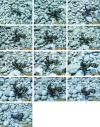Bipedal locomotion in Octopus vulgaris: A complementary observation and some preliminary considerations
- PMID: 33976767
- PMCID: PMC8093653
- DOI: 10.1002/ece3.7328
Bipedal locomotion in Octopus vulgaris: A complementary observation and some preliminary considerations
Abstract
Lacking an external shell and a rigid endoskeleton, octopuses exhibit a remarkable flexibility in their movements. Bipedal locomotion is perhaps the most iconic example in this regard. Until recently, this peculiar mode of locomotion had been observed only in two species of tropical octopuses: Amphioctopus marginatus and Abdopus aculeatus. Yet, recent evidence indicates that bipedal walking is also part of the behavioral repertoire of the common octopus, Octopus vulgaris. Here we report a further observation of a defense behavior that encompasses both postural and locomotory elements of bipedal locomotion in this cephalopod. By highlighting differences and similarities with the other recently published report, we provide preliminary considerations with regard to bipedal locomotion in the common octopus.
Keywords: Octopus; behavioral flexibility; bipedal; cephalopods; locomotion; walking.
© 2021 The Authors. Ecology and Evolution published by John Wiley & Sons Ltd.
Conflict of interest statement
Authors declare that they have no conflict of interest.
Figures


Similar articles
-
Underwater bipedal locomotion by octopuses in disguise.Science. 2005 Mar 25;307(5717):1927. doi: 10.1126/science.1109616. Science. 2005. PMID: 15790846
-
Locomotion by Abdopus aculeatus (Cephalopoda: Octopodidae): walking the line between primary and secondary defenses.J Exp Biol. 2006 Oct;209(Pt 19):3697-707. doi: 10.1242/jeb.02435. J Exp Biol. 2006. PMID: 16985187
-
The best defense is a good offense: Anti-predator behavior of the common octopus (Octopus vulgaris) against conger eel attacks.Ecol Evol. 2024 Mar 19;14(3):e11107. doi: 10.1002/ece3.11107. eCollection 2024 Mar. Ecol Evol. 2024. PMID: 38510541 Free PMC article.
-
Locomotion in bonobos (Pan paniscus): differences and similarities between bipedal and quadrupedal terrestrial walking, and a comparison with other locomotor modes.J Anat. 2004 May;204(5):353-61. doi: 10.1111/j.0021-8782.2004.00292.x. J Anat. 2004. PMID: 15198700 Free PMC article. Review.
-
Recent Advances in Bipedal Walking Robots: Review of Gait, Drive, Sensors and Control Systems.Sensors (Basel). 2022 Jun 12;22(12):4440. doi: 10.3390/s22124440. Sensors (Basel). 2022. PMID: 35746222 Free PMC article. Review.
Cited by
-
Transcriptome-wide selection and validation of a solid set of reference genes for gene expression studies in the cephalopod mollusk Octopus vulgaris.Front Mol Neurosci. 2023 May 17;16:1091305. doi: 10.3389/fnmol.2023.1091305. eCollection 2023. Front Mol Neurosci. 2023. PMID: 37266373 Free PMC article.
-
In situ light-field imaging of octopus locomotion reveals simplified control.Nature. 2025 Aug 6. doi: 10.1038/s41586-025-09379-z. Online ahead of print. Nature. 2025. PMID: 40770102
-
Topology, dynamics, and control of a muscle-architected soft arm.Proc Natl Acad Sci U S A. 2024 Oct 8;121(41):e2318769121. doi: 10.1073/pnas.2318769121. Epub 2024 Oct 1. Proc Natl Acad Sci U S A. 2024. PMID: 39352928 Free PMC article.
References
-
- Amodio, P. , Shigeno, S. , & Ostojić, L. (2020). Evolution of intelligence in cephalopods. eLS, 1, 77–84. 10.1002/9780470015902.a0029004 - DOI
-
- Amor, M. , Doyle, S. , Norman, M. , Roura, A. , Hall, N. , Robinson, A. , Leite, T. , & Strugnell, J. (2019). Genome‐wide sequencing uncovers cryptic diversity and mito‐nuclear discordance in the octopus vulgaris species complex. bioRxiv, 573493. 10.1101/573493 - DOI
-
- Borrelli, L. , Gherardi, F. , & Fiorito, G. (2006). A catalogue of body patterning in cephalopoda. Firenze University Press.
-
- Chellapurath, M. , Stefanni, S. , Fiorito, G. , Sabatini, A. M. , Laschi, C. , & Calisti, M. (2020). Locomotory behaviour of the intertidal marble crab (Pachygrapsus marmoratus) supports the underwater spring‐loaded inverted pendulum as a fundamental model for punting in animals. Bioinspiration and Biomimetics, 15(5), 055004. 10.1088/1748-3190/ab968c - DOI - PubMed
-
- De Luca, D. , Catanese, G. , Procaccini, G. , & Fiorito, G. (2014). An integration of historical records and genetic data to the assessment of global distribution and population structure in Octopus vulgaris . Frontiers in Ecology and Evolution, 2, 55. 10.3389/fevo.2014.00055 - DOI
LinkOut - more resources
Full Text Sources
Other Literature Sources

